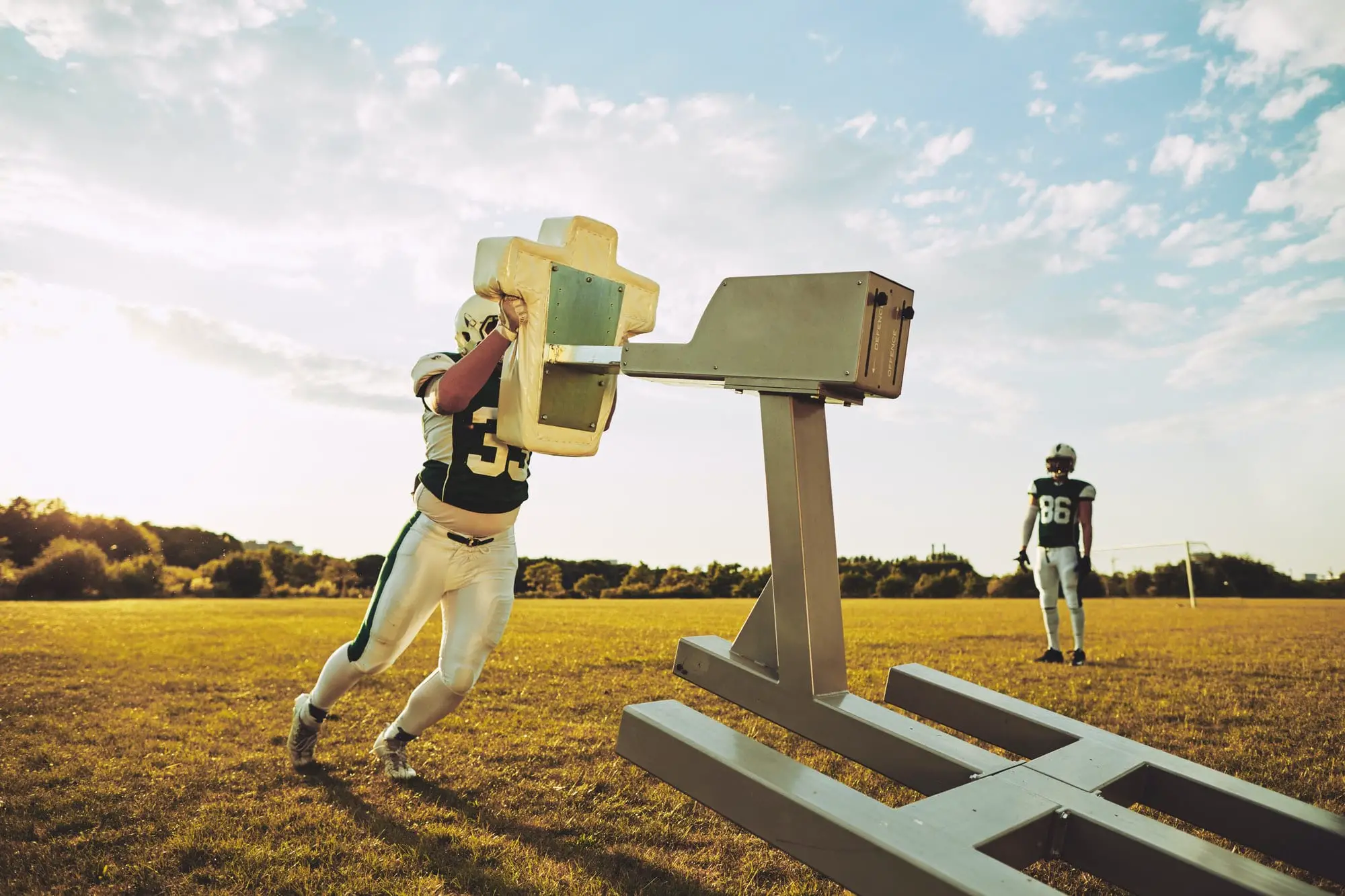You can use a variety of cleats for different types of field sports so long as the sports or rules committee permits it. But can you use football cleats for soccer?
A football cleat might seem comfortable at first and might not even look all that different, but even if you’re allowed to wear it on a soccer pitch, there are a ton of reasons why you shouldn’t.
Football cleats are simply built differently and you’ll do yourself more harm than good if you use them for soccer. So, no – you can’t and shouldn’t use football cleats for soccer.
Since soccer players need their agility and freedom, all soccer cleats come in a low-cut style. Such design allows for ankle maneuverability.
On the other hand, football cleat features a different style. It has a mid-top design that supports the entire ankle, which doesn’t give as much ankle freedom as soccer cleats.
That design is best for linemen since it supports the lateral movements required for that position.
Football cleats are specially designed for only football and while you can use them casually for other sports, competitive and official leagues don’t allow them.
Using football cleats for soccer will make your game struggle. And at the end of the day, you’ll still have to use standard soccer cleats in official leagues.
Aside from struggling in the game, you can also sustain injuries since football cleats aren’t designed for soccer.
Football cleats are mid-cut shoes and they cover only a portion of the ankle. They are perfect for players in the running backs, defensive backs, quarterbacks, and wide receivers.
The cut provides support but it doesn’t allow for more ankle movement compared to low-cut soccer cleats. Nonetheless, some defensive backs still go for low-cut shoes.
Low-cut shoes are lightweight and allow maximum running speed.
Difference in Looks
Football cleats look bulkier and heavier than soccer cleats. They usually have thick padding and are made of thick leather.
The cleats below the shoe are also really long compared to soccer cleats. They help a football player dig into the pitch for extra traction, allowing quick turns and cuts.
Football cleats can be either low, mid, or high-cut. Each design has its own benefits and various football positions go for a certain type of football cleats that improves their performance.
Are soccer cleats and football cleats the same? Short answer – no, they aren’t.
Soccer cleats can be mistaken for football cleats, but they are very different and are listed below.
Main Difference Between Both Cleats
The major difference between football cleats and soccer cleats isn’t in their looks. They both look alike and most times telling the difference can be difficult.
However, you can tell the difference in their outsole, weight, and designs (high-top and mid-top). Here’s how to tell the difference between football cleats and soccer cleats:
Design
Soccer boots are designed to be light to maximize speed. That’s the reason they’re built mostly in a low-cut design to allow the ankle muscles to move with ease. Football cleats are often made low, mid, or high-cut. They vary based on your style of play and position. High-cut boots maximize ankle support.
Mid-cut cleats combine a balance between ankle support and speed while low-cut cleats maximize speed.
Depending on your position and playstyle as a football player you’ll have to go for a certain design of football cleats.
Linemen go for high-cut cleats since they offer ankle support required for their position. Defensive backs, wide receivers, running backs, and quarterbacks often prefer using mid-cut.
That said, defensive backs also use low-cut cleats for maximum speed. And there are also some soccer cleats that are high-cut like the mercurial superfly 360.
Outsole
Soccer cleats outsoles usually feature removable aluminum cleat caps that improve durability and traction. Modern soccer cleats molds outsoles designed for harder outdoor surfaces. Football cleats also use molded and removable cleats. But they have a toe cleat you can’t find in soccer cleats.
Molded cleats are important and the safety standards for youth since they tend to cause fewer injuries than other cleats. And they’re less expensive.
Detachable football cleats are either built from hard plastic, rubber, or metal. One of the major differences between soccer and football cleats is that football cleats often come with a toe spike.
The spike close to the big toe provides extra traction for when you’re pushing forward against or blocking a tackler, which is why it’s important to football players.
In soccer, adding a spike near the front toe of the cleat will interfere with ball control, first touches, passes and shots. Given the nature of soccer, players are better off without the toe spike.
Construction
Soccer cleats are designed to be lightweight to support the feet for long hours of running. Manufacturers use mostly rubber or polyurethane outsoles which are durable and light.
Soccer boots are also built for stability thereby having close to no midsole, so players’ feet can be as close to the ground as possible. The upper parts of the cleats are made from either synthetic or leather depending on preference.
Football cleats can be the complete opposite of soccer cleats when it comes to construction. Instead of lightweight, football players favor thick and heavy padding for more protection.
Football cleats usually come with a heavier material build and thicker outsoles. However, the same materials are used for soccer cleats. The difference is that they use either synthetic or leather with heavier variety.
While both cleats are different, they’re built to be durable on the pitch and rough grass surface.
Toe Feel
Unless you’re a kicker or a punter, striking area response and toe feel don’t really matter to a football player. Companies who produce soccer cleats make much attention and effort in engineering striking and toe areas that feel responsive and natural.
In addition to a comfortable fit and traction, you must get a consistent touch response to lob a pass, dribble the ball, or fire a shot. For that reason, you will want to go for soccer cleats that are seamless and fit snugly.
On the other hand, it doesn’t really matter as much for football cleats, and if you find yourself in between sizes, it’s fine to select a larger cleat that is more comfortable.
If You Use Football Cleats for Soccer
Even if you get football cleats that are your size, using them for soccer remains a bad idea. It can affect your game performance and lead to injuries.
They are not designed for soccer and using them for soccer will make your game suffer. Here’s what happens when you use football cleats for soccer:
Game Performance
Since football cleats have a high-top design unlike soccer cleats, they affect how easily you can move your ankle on the pitch, especially when on the run.
Standard soccer cleats are lightweight and slimmer than football boots. They are also more fitting than football boots.
So, there’s a difference between when you hit the ball with a standard soccer cleat and when you hit it with a soccer cleat. There’s also a difference in your first touch.
Modern soccer cleats are designed to be seamless and fitting. They are built to make you feel barefoot on the ball. And this improves your first touch.
But that’s not exactly the case with football boots. Only the kicker needs to make contact with his boots, so first touch and control aren’t exactly in the minds of football boots makers.
They rather focus on good material and sturdiness.
If your soccer boots aren’t fitting and seamless it’ll affect your first touch, control, and overall game performance.
Possible Injuries
Common problems from wearing the wrong soccer cleats on the pitch include metatarsalgia, sesamoiditis, Hallux rigidus, black toe, bunions, and metatarsal stress fractures.
Achilles tendonitis and Haglund’s deformity can also occur if the football cleats are tight and cutting into the rear of your foot.
The football cleat can result in the stud being directly under the first MTP joint. That will affect the joint and the sesamoids, the two tiny bones directly under the joint protecting it.
While all the above injuries are less likely to occur as football cleats and soccer cleats are almost alike, the danger truly lies in wearing tight or oversized football cleats for soccer.
Using Football Cleats on Other Sports
Can Football Cleats be Used for Lacrosse?
While cleats not built for a particular sport might easily break when you use them for that sport, a football cleat won’t break easily you’re using one made with substandard materials. You can always use football cleats for lacrosse during unofficial games. But if it’s an official game, football cleats aren’t the best for the best performance.
Can Football Cleats be Used for Track?
Except the track is loose dirt or turf grass, then you shouldn't use football cleats for track games. Even though it might feel comfortable enough to be used, track officials strongly forbid it. It is unsafe to use football cleats on a synthetic track made with compressed clay. The hinges underneath the boot would disturb your balance and you could fall.
Can Football Cleats be Used for Paintball?
Football cleats are generally light and comfortable for almost every field sport, but they aren’t best for all. They are flexible and heavier than soccer and baseball cleats, but that's not what’s needed for paintball. However, people use it since it is cheaper than paintball cleats.
Our Advice
You can find an unprofessional soccer player using football cleats for soccer and not be able to tell as they look alike, but the player is often the one who experiences the difference.
Both cleats are built alike with the same materials, but they are not built for the same purposes and don’t feel the same on the feet.
Also Read: What Shoes to Wear for Track and Field?

Austin is the author of loveatfirstfit.com and a personal trainer with extensive knowledge in nutrition. Austin is passionate about helping others to find a suitable healthy lifestyle and feel good about themselves. Austin’s goal is to help people push their limits and achieve their physical performance.

